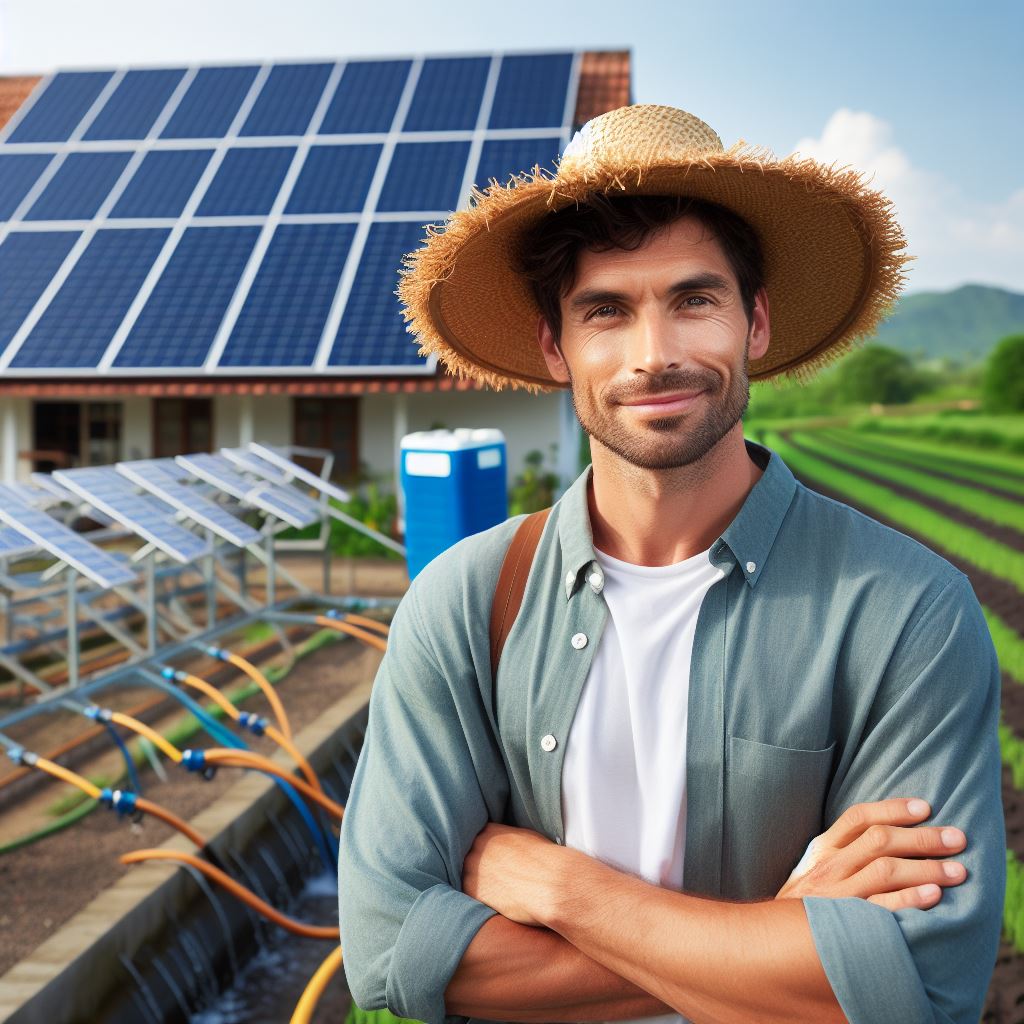Introduction
Wind power is becoming increasingly popular in the energy sector. As the demand for energy continues to rise, the importance of agriculture in meeting the world’s food needs cannot be overstated.
However, it is crucial to consider the potential impact that wind power may have on agriculture.
In the ever-evolving landscape of sustainable energy solutions, the intersection of wind power and agriculture emerges as a compelling subject of study and innovation.
As societies worldwide grapple with the pressing need to transition towards cleaner and more efficient energy sources, the profound impact of wind power on agriculture has become a focal point of discussion.
This symbiotic relationship holds the promise of not only meeting the escalating energy demands but also revolutionizing the way we approach farming practices.
In this exploration, we delve into the multifaceted dimensions of how wind power, with its inherent environmental benefits and technological advancements, is influencing and reshaping the agricultural sector.
Overview of Wind Power
Wind power is a renewable energy source that is harnessed by capturing the kinetic energy of wind and converting it into electrical energy.
This clean and sustainable form of power generation has gained significant momentum in recent years.
Globally, the wind power industry has experienced remarkable growth.
The demand for sustainable energy solutions has propelled the expansion of wind farms and the installation of wind turbines in various parts of the world.
The Concept of Wind Power
Wind power is generated by harnessing the force of the wind through wind turbines.
These turbines consist of large blades that rotate when they catch the wind, activating a generator that produces electricity.
This process is known as wind energy conversion.
Wind turbines are typically installed in wind farms, which are vast areas of land where multiple turbines are strategically placed to maximize energy production.
The height and positioning of these turbines are optimized to capture as much wind energy as possible.
Transform Your Agribusiness
Unlock your farm's potential with expert advice tailored to your needs. Get actionable steps that drive real results.
Get StartedThe Growth of the Wind Power Industry Globally
The wind power industry has experienced exponential growth on a global scale over the past decade.
Countries around the world have recognized the importance of transitioning to cleaner and more sustainable energy sources.
According to data from the Global Wind Energy Council, the global capacity of wind power reached 651 GW by the end of 2020, a significant increase from just 17.4 GW in 2000.
This growth can be attributed to several factors, including technological advancements, cost reductions, and increased environmental awareness.
China leads the world in wind power capacity, followed by the United States, Germany, and India.
These countries have made substantial investments in wind energy infrastructure, resulting in a substantial increase in the number of wind turbines and the overall generation of wind power.
Increasing Use of Wind Power: Statistics and Facts
Wind power has become an integral part of the global energy mix, and its usage continues to increase rapidly.
The following statistics and facts highlight the escalating adoption of wind power:
- In 2020, wind power accounted for 8% of the global electricity demand, and this figure is expected to rise in the coming years.
- The installation of wind power capacity in 2020 alone reached a record-breaking 93 GW.
- Wind power is cost-competitive with traditional forms of energy generation, and its levelized cost of electricity has significantly declined over the past decade.
- Wind turbines have a lifespan of approximately 20-25 years, making them a reliable and long-term solution for sustainable energy production.
- Wind power contributes to reducing greenhouse gas emissions and mitigating climate change, as it produces zero carbon dioxide emissions during operation.
- Wind farms have the potential to revitalize rural communities by providing economic opportunities through land lease agreements and job creation
- The offshore wind power sector is rapidly growing, with countries like the United Kingdom, Germany, and the Netherlands investing heavily in this form of renewable energy.
In short, wind power has emerged as a significant player in the global energy industry.
Its sustainable and environmentally friendly nature, coupled with its increasing competitiveness, has catapulted wind power into the spotlight.
As the world continues to prioritize clean energy solutions, wind power is expected to play a vital role in meeting the growing demand for electricity while reducing carbon emissions.
Read: Solar Energy: Changing Agriculture
Advantages of wind power for agriculture
Economic benefits for farmers
- Wind power provides a lucrative opportunity for farmers to earn additional income.
- By harnessing wind energy, farmers can sell the electricity generated back to the grid.
- This creates a new revenue stream, boosting the economic stability of farming operations.
Potential for reducing energy costs
- Traditional energy sources, such as fossil fuels, can be expensive for farmers.
- Wind power offers a sustainable and cost-effective alternative for meeting energy needs on the farm.
- By installing wind turbines, farmers can reduce their reliance on expensive electricity from the grid.
- This leads to significant savings and decreases the overall operational costs of running a farm.
Stable income source through lease agreements
- Many farmers have land that may not be suitable for cultivating crops or rearing livestock.
- Such lands can be leased out for wind turbine installations, generating a stable source of income.
- Lease agreements with wind power companies provide farmers with long-term financial security.
- Even during times of drought or market fluctuations, the income from wind power remains constant.
Environmental advantages
- Wind power is a clean and renewable source of energy, reducing the environmental footprint of agriculture.
- Using wind turbines to generate electricity does not produce harmful greenhouse gas emissions.
- This helps in combatting climate change and promoting sustainable farming practices
- Decreased reliance on fossil fuels also mitigates air and water pollution, benefiting both farmers and the surrounding community.
Diversification of income sources
- Wind power enables farmers to diversify their income sources and reduce dependence solely on agriculture.
- Income from wind energy can act as a buffer during times of agricultural market volatility.
- This additional income can be invested in farm modernization, equipment upgrades, or expansion of operations.
Job creation opportunities
- The wind power industry brings about job opportunities for rural communities.
- Installing and maintaining wind turbines requires skilled labor, providing employment possibilities for local residents.
- These job opportunities help to revitalize rural economies, supporting farmers and the wider community.
Increased energy independence
- By generating their own electricity on-site, farmers become less reliant on external energy sources.
- Unforeseen events, such as power outages, do not disrupt farm operations.
- Having control over energy production enhances the overall sustainability and resilience of the farm.
In fact, wind power offers numerous advantages for the agricultural sector.
It provides economic benefits to farmers by offering additional sources of income, reducing energy costs, and ensuring financial stability through lease agreements.
Furthermore, wind power promotes environmental sustainability, diversifies income sources, creates job opportunities, and increases energy independence.
Implementing wind power in agriculture can lead to a more sustainable, resilient, and economically viable future for farmers.
Read: Eco Farming: Harnessing the Sun Power
Challenges Faced by Farmers Due to Wind Power
Potential challenges faced by farmers due to the installation of wind turbines
Farmers have been facing several potential challenges due to the installation of wind turbines.
These challenges range from the impact on agricultural land and the environment to the effects of noise and vibrations on livestock.
Impact on Agricultural Land and the Environment
One of the primary concerns raised by farmers regarding wind power is its impact on agricultural land.
The installation of wind turbines requires large areas of land, which can potentially reduce the available land for farming.
Moreover, the construction of wind farms often involves the excavation of land, which disrupts the natural soil composition and affects its fertility.
This alteration in soil quality can limit crop yields and pose challenges for farmers.
The presence of wind turbines can also impact the local ecosystem, affecting wildlife habitats and migration patterns.
Showcase Your Farming Business
Publish your professional farming services profile on our blog for a one-time fee of $200 and reach a dedicated audience of farmers and agribusiness owners.
Publish Your ProfileThis can disrupt the balance within the ecosystem and potentially harm biodiversity in the surrounding areas.
Noise and Vibrations’ Effect on Livestock
Another significant challenge faced by farmers is the noise and vibrations emitted by wind turbines, which can have adverse effects on livestock.
The constant noise produced by the rotating blades can disturb animals, causing stress and potential health issues.
This disturbance can affect animals’ feeding and resting patterns, ultimately impacting their overall well-being.
Additionally, the vibrations generated by wind turbines can create a sense of unease among livestock, leading to increased stress levels.
This stress can compromise their growth and productivity, affecting the economic viability of livestock farming.
Mitigation Strategies
To address these challenges, several mitigation strategies can be implemented:
- Strategic placement of wind turbines away from prime agricultural land to minimize negative effects on farming activities.
- Implementation of proper land management practices after turbine installation to restore soil fertility and prevent long-term damage.
- Development of wildlife conservation plans to protect and enhance the local ecosystem and mitigate the impact on biodiversity.
- Utilization of advanced engineering techniques to reduce noise levels produced by wind turbines, minimizing disturbance to livestock.
- Provision of adequate buffer zones between wind turbines and livestock areas to minimize vibrations and alleviate stress on animals.
Potential Benefits
Despite the challenges, wind power also offers several potential benefits to farmers:
- Lease agreements with wind power companies can provide additional income sources for farmers, supporting their agricultural operations.
- Wind turbines can act as windbreakers, reducing wind erosion and protecting crops from damage.
- Transitioning to renewable energy sources like wind power contributes to a sustainable farming system, aligning with environmental goals and reducing carbon emissions.
- Wind power can enhance a farm’s resilience by diversifying its income streams and reducing reliance on traditional agriculture.
In essence, farmers face various challenges due to the installation of wind turbines, including the impact on agricultural land, the environment, and the well-being of livestock.
However, by implementing mitigation strategies and exploring the potential benefits, farmers can adapt to these challenges and harness the advantages offered by wind power in an environmentally conscious manner.
Read: Sun, Wind, Soil: Farming’s Future

Case studies and examples
Wind power has emerged as an important source of renewable energy in recent years.
It not only provides clean and sustainable power but also has a positive impact on agriculture.
This section explores real-life examples, success stories, and innovative practices that highlight the benefits of integrating wind power into farms.
Real-Life Examples of Wind Power’s Positive Impact on Agriculture
- Case Study 1: A farmer in Iowa installed wind turbines on his land, generating electricity that covers 100% of his farm’s energy needs. This has significantly reduced his operational costs and made his farm more sustainable.
- Case Study 2: In California, a vineyard owner has integrated wind turbines into his farm’s irrigation system. The turbines generate power that is used to pump water, reducing the farm’s reliance on traditional energy sources and saving on utility bills.
Success Stories of Farmers Integrating Wind Power
- Farmer John Smith from Kansas decided to invest in wind power to supplement his income. He installed several wind turbines on his property and now sells the excess electricity back to the grid, generating a consistent revenue stream.
- Mary Johnson, a dairy farmer in Vermont, integrated wind power into her farm to reduce her carbon footprint. The wind turbines provide electricity for the farm, allowing her to reduce the use of conventional power sources, resulting in lower emissions.
Innovations and Best Practices
- Community Wind Farms: Several communities have come together to develop wind farms, enabling small farmers to benefit from wind power without investing in individual turbines. This collaborative approach has proven successful in reducing costs and increasing the adoption of wind power.
- Micro Wind Systems: Innovations in micro wind systems have made it possible for farmers with limited land resources to harness wind power. These smaller turbines can be installed on rooftops or in fields, providing a decentralized energy source for individual farms.
- Wind-Powered Irrigation: Farmers are increasingly using wind power to run irrigation systems. This practice not only saves on energy costs but also reduces reliance on groundwater, making agriculture more sustainable in water-scarce regions.
- Wind-Breaking Techniques: Farmers have found that strategically placing wind turbines as windbreakers can protect crops from strong winds, preventing soil erosion and crop damage. This innovative use of wind power contributes to maintaining healthy and productive farmland.
In general, wind power has proven to be a game-changer in agriculture, providing numerous benefits for farmers.
Real-life examples have showcased the positive impact of wind power, reducing operational costs and emissions, and generating additional income for farmers.
The success stories of integrating wind power into farms highlight the potential for widespread adoption.
Innovations such as community wind farms, micro wind systems, wind-powered irrigation, and wind-breaking techniques continue to emerge, further enhancing the benefits of wind power in agriculture.
As the world embraces sustainable energy solutions, wind power’s impact on agriculture will continue to grow, creating a greener and more prosperous future for farmers.
Read: Green Farming: Biomass Energy Benefits
Government policies and incentives
The role of government policies and incentives in promoting wind power cannot be overstated.
Governments around the world have recognized the importance of renewable energy sources, including wind power, to reduce carbon emissions and combat climate change.
Financial support and subsidies for farmers
Farmers play a crucial role in the adoption of wind power as they have ample land available for installing turbines.
To encourage farmers to invest in wind power, many governments provide financial support and subsidies.
These subsidies can come in different forms, such as tax credits, grants, or low-interest loans.
They help reduce the initial investment cost for farmers and make wind power projects more financially viable.
Including agriculture sector stakeholders
One crucial aspect of formulating effective wind power policies is including stakeholders from the agriculture sector in policy discussions.
Farmers, agricultural associations, and cooperatives should have a seat at the table when decisions are being made.
By involving these stakeholders, policymakers can gain valuable insights into the specific needs and challenges faced by farmers in adopting wind power.
This collaborative approach ensures that policies are practical and address the concerns of the agriculture sector.
The importance of government support
Government support is vital in promoting wind power in agriculture.
It provides the necessary framework and incentives for farmers to embrace renewable energy sources and mitigate climate change.
Financial support is particularly crucial as it helps alleviate the financial burden and risks associated with transitioning to wind power.
It enables farmers to invest in the necessary infrastructure and equipment, such as wind turbines and grid connections.
Policy stability and long-term planning
Another critical aspect of government policies is stability and long-term planning.
Wind power projects require substantial investments and have long lifespans.
Therefore, farmers need assurance that the policies supporting wind power will remain consistent and predictable over time.
Unforeseen changes in policies or the sudden removal of subsidies can have a detrimental impact on the confidence of farmers and hinder the growth of wind power in the agriculture sector.
International examples of government support
Several countries have successfully implemented government policies and incentives to promote wind power in agriculture.
Denmark, for instance, has a long history of supporting renewable energy.
Showcase Your Farming Business
Publish your professional farming services profile on our blog for a one-time fee of $200 and reach a dedicated audience of farmers and agribusiness owners.
Publish Your ProfileThe Danish government offers favorable feed-in tariffs and tax exemptions for renewable energy production.
As a result, wind power has become a significant source of income for Danish farmers.
In the United States, the federal government provides a production tax credit for wind power generation.
This incentive has encouraged many farmers to install turbines on their land, diversifying their income streams and contributing to the country’s renewable energy goals.
In a nutshell, government policies and incentives play a crucial role in promoting wind power in agriculture.
Financial support and subsidies reduce the barriers for farmers to adopt wind power, while including stakeholders ensures their voices are heard in policymaking.
Ultimately, with government support, wind power has the potential to revolutionize the agricultural sector by providing clean and sustainable energy while benefiting farmers financially.
It is essential for governments to continue developing and implementing policies that facilitate the growth of wind power in agriculture.
Conclusion
The potential impact of wind power on agriculture is largely positive.
It offers numerous benefits such as reducing carbon emissions and providing a reliable source of clean energy.
While concerns about the visual impact and noise generated by wind turbines exist, proper planning and site selection can help mitigate these challenges.
Moreover, wind power can coexist harmoniously with agriculture, as the land beneath wind turbines can still be used for farming, grazing, or other agricultural activities.
The integration of wind power in agriculture can lead to a more sustainable future.
It offers an opportunity to meet energy demands while reducing reliance on fossil fuels and minimizing environmental harm.
With continued innovation and advancements in technology, potential concerns can be effectively addressed, ensuring a positive and mutually beneficial relationship between wind power and agriculture.
As we move forward, it is crucial to prioritize sustainable energy solutions that work hand in hand with agriculture, preserving the health of our planet for future generations.




